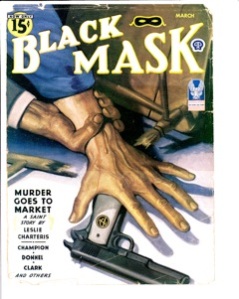“Black Mask Magazine, Steve Fisher, and The Noir Revolution” by Keith Alan Deutsch
 Keith Alan Deutsch is publisher and conservator of Black Mask Magazine, a publication that has a long-established connection to EQMM. He is also the co-author of several reference and scholarly books relating toBlack Mask, hardboiled, and noir fiction. They include Black Mask Pulp Story Reader Volumes 1 – 6, Jo Gar’s Casebook, and The Black Lizard Big Book of Black Mask Stories. His knowledge of key publications and acquaintance with many of the genre’s writers put him in a position to provide a fascinating overview of the field.—Janet Hutchings
Keith Alan Deutsch is publisher and conservator of Black Mask Magazine, a publication that has a long-established connection to EQMM. He is also the co-author of several reference and scholarly books relating toBlack Mask, hardboiled, and noir fiction. They include Black Mask Pulp Story Reader Volumes 1 – 6, Jo Gar’s Casebook, and The Black Lizard Big Book of Black Mask Stories. His knowledge of key publications and acquaintance with many of the genre’s writers put him in a position to provide a fascinating overview of the field.—Janet Hutchings
It is difficult to remember seventy-five years after the revolution, but Steve Fisher, Cornell Woolrich, and a few other second-wave Black Mask boys of the late 1930s ushered in a sea change in crime-fiction narration.
Fanny Ellsworth, who replaced Joseph Shaw at Black Mask in 1936, favored this change from the objective, hardboiled writing promoted by Shaw and the earlier editors of Black Mask Magazine to the subjective, psychologically and emotionally heightened writing that came in vogue under her guidance.
This little-noticed shift in style in Black Mask fiction, “The Ellsworth Shift,” led to the creation of the film genre we now know as noir through the writings of Steve Fisher, particularly in his film scripts, and through the novels and short fiction of Cornell Woolrich, whose writings we now also call noir, although the term was originally applied only to film.
This dark new style and psychology in crime-fiction narration jumped from magazine and book publications into screenplays, and led in the 1940s to the emergence in Hollywood of the classic age of the noir film thriller.
The obsessive, dreamlike narration favored by Fisher and Woolrich in their tense crime tales was a perfect match for the dark shadows and frightening, expressive camera angles developed in German and Hollywood horror cinema. Narrative fiction style and camera photography styles played against and enriched each other in the development of this new film genre.
for the rest go here: http://somethingisgoingtohappen.net/2012/08/29/black-mask-magazine-steve-fisher-and-the-noir-revolution-by-keith-alan-deutsch/
BE SURE TO READ JON BREEN'S LETTER IN COMMENTS FOLLOWING THE ARTICLE









NO COMMENTS: